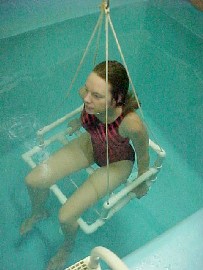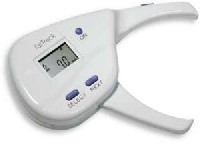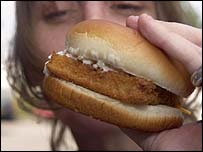

You probably recognize the "beer gut" on the fellow in the photo on the left. I found the photograph on the Internet, but it could have been a photograph in anyone's personal collection of family and friends. Or it could even be yourself. He is typical of many overweight Americans. The guy in the photo is not "severely" overweight, but he is well on his way. Medically, he is considered "obese". As a general rule, anyone is considered borderline obese if they have a size 35" waistline (females) or a size 40" waistline (males). The belt size is not a very accurate measurement though. In a moment, I will define obesity more precisely. I don't mean to "pick on" the millions of Americans that have the same problem as the guy pictured above. My intent is to educate and warn about the perils. I realize, of course too, that there are those who are downright militant about the subject. They would rather continue believing that they can train the world to perceive "fat as beautiful"; and take the staunch position that those who are obese should "accept" the obesity along with the rest of society. From my experience and point of view, it's a lofty, unrealistic goal and it fails to address the physical health implications of obesity.
My mother is obese. I have a younger brother that is obese. His wife is obese. His oldest son is obese. Look around--obesity is everywhere. It is a growing epidemic here in America. A recent article in USA Today (October 13, 2003) pointed out the alarming fact that if the overweight problem is not reined in somehow, obesity will affect 40% of the population by the Year 2010. Currently, 31% of all Americans are obese according to the medical definition. I would not be writing this article if this was something that is as inevitable as old age. We cannot stop the process of growing old, but we can stop the process of continuously gaining weight to the point that it is totally out of control. And even if it has gotten out of control, we can do something to reverse the process. Doctor's here in America define obesity as anyone who is 20% above or more of the ideal weight (according to height, sex and body frame) on the charts published by the American Medical Association. If you are curious about yourself, you can check out the charts and method for calculating which body frame you are (small, medium or large) using the techniques located at this link on the web. It uses the breadth of one's elbow bone as a reference. The elbow bone is not layered with fat and therefore offers a reliable site of reference that is accurate for assessing body builds of skinny and fat people alike. A word of caution, however. There are exceptions to these charts. These charts generalize body types and do not take into account the ratio of body fat to lean muscle mass. Consequently, bodybuilders and pro athletes would probably all qualify for being obese if one goes by these charts alone. For these exceptional people, their body weight alone does not tell them much. To prove this point, let's look at an example. Suppose there are two people weighing 186 lbs. Let's further assume they are both 5' 11". Lets assume that person A is 50% body fat and person B is 5% body fat. Both people are the same weight, but they are still quite different. Person A consists of 93 lbs of pure body fat, compared to person B who consists of only 9.3 lbs of body fat. Person A is overweight and classified obese. Person B, on the other hand, is leaner and more muscular. Person B is not obese. The point is that unless one takes into account the percentage of body fat for manufacturing theses charts, they can be very misleading for those people who have a lot of lean, muscular tissue. If you fall in this category, knowing your percentage of body fat is the best way to assess whether or not you are overweight and obese.
The best method for determining your body fat percentage is hydrostatic weighing. It calculates a person's body fat percentage by comparing their body weight on dry land to their body weight under water. It doesn't cost much either. You spend about $10 - $70, depending on going price in your area. Here's an example. Usually you can find out where to get his done by consulting your doctor, calling some of the larger health facilities or contacting your local universities. I know, for example here in Georgia, Georgia State University has a very thorough physiology testing facility. Another method you can use to measure your body fat percentage is called bioelectrical impedance. I first found out about this while attending the Super Show here in Atlanta for the sports industry. These systems employ devices that measure your fat ratio based on how small amounts of electrical current are able to pass through various areas of your body. Fat has a different conductivity level (impedance) than does lean tissue.
I recently ordered some "fat calipers" from a classified ad in Runners World magazine. It pinches skin folds. The device came with a small book that showed me where and how to pinch the skin. It had all kinds of charts telling me how to determine what was a healthy level of body fat, and how to use the measurements to calculate overall body fat. The book says that males should keep their body fat percentages below 20% and females should keep their body fat percentages below 28%. However, I want to be realistic in this article. I know most people reading this are not going to invest the money or time trying to measure their percentage of body fat. So to that general body of people I ask that you at least give yourself the "Pinch Test". You do this by grasping the skin at the side of the waist and measuring the fold, a measurement of more than an inch is an indication of overweight. And even if that is too much of an effort because you have to track down a ruler, then give yourself the "Jump Test". That is, stand in front of a full-length mirror and jump. Anything that shakes is excess fat. For most people, the charts that I mentioned earlier will give a pretty accurate assessment of what should be considered obese. The exception, like I mention, are the bodybuilders and athletes. Most of us are not in that category. Take me, for example. By the time I was in my early 50's, I had gotten up to 218 lbs. According to the official charts and elbow bone measurements, I am a large body frame. I am 6'2" tall. Taking into account that I have a little better than average amount of muscle, I estimate that should be around 185 lbs (midpoint of large frames) in order to be the "ideal weight". A 20% weight increase for my ideal weight would have placed me at 222 lbs. Obviously, I was only 7 pounds away from becoming borderline obese. I could see the difference. I was beginning to develop a slight "beer gut" and I was beginning to develop a double chin. And worst of all, I could really feel the difference. I had gradually stopped exercising. It was becoming increasing difficult for me to exercise without rapidly becoming exhausted or being easily injured. This was because I was overweight, but trying to do the same level of exercise that I once did as a much skinnier person. I knew I had to take immediate evasive action to stop the trend and gradually lose the weight to a healtheir level.
In my own case, and as with most other people, my gaining weight was a gradual process. My senior year in high school (1961), I only weighed 127 lbs. (That was the weight class in which I competed as a wrestler on my high school team.) That was too skinny. I purposely tried to gain weight after graduating. By the time I had gotten out of the Army basic training (1964), I weighed 146 lbs. Thereafter, I gained 1 to 2 lbs every year. That doesn't seem like much when one looks at it on an annual basis, but in the course of 25 to 30 years that annual gain can become one heck of a lot of weight to accumulate.
There are two problems: (1) diet and (2) exercise. The food culture in America has been compared to a "toxic environment". That is, all the bad things about diet are constantly there for your consumption. Portions are twice as big as they were 20 years ago. Servings of hamburgers, chips, fries and a soft drink have 50 to 100 calories more. Such a meal was not good for you in the first place, but it is even worse now. Food is everywhere and we are constantly being bombarded with tempting advertisements for high carbohydrate (and high calorie) items.
As for exercise, a recent study shows that only 45% of adults meet the government's minimum recommendation of at least 30-minutes of moderate activity daily. With the longer work hours, paranoia of being unemployed, and the longer commutes, there are fewer opportunities for exercise. Because of e-mail, phone and video conferencing, many of us seldom get up from our desks at work any more except to go to lunch, the restroom, or the candy bar and coffee machines. We are glued to our computers, never even walking to a meeting somewhere else in the building any more. That's enough excuses! I have used these excuses as a means to avoid taking any action, so I know personally how convenient it is to blame our toxic food environment and the demands of a 12-hour work day. What I want to do now is talk about diet and exercise and tell you, in my opinion, what CAN be done to stop the escalation of the problem; and in most cases, help a person lose weight to a safer level. I had to address the problem myself and I was successful. Hopefully what I have learned and read along the way, might help anyone who is approaching the problem currently. I'm not trying to turn "big-boned" women into skinny runway super models, nor am I trying to turn men into sculptured body builders. I just would like to see a concerted attempt in America for all of us to exit the obesity classification and avoid it altogether. I want everyone to live long and happy lives without weight being a contributor to physical fat-related ailments or induced mental depression. Realistic Exercising We have to find time to exercise. Personally, I get up 5 days a week at 4am and run 4-miles. This gives me time to cool down, take my morning shower and get ready for work, and then drive the 1:10 commute in order to be in my office by 6:30am. That works for me, but it would probably not work for most people. It also requires that I make it to bed each night no later than 10pm. You have to get an ample amount of sleep or you risk other problems. Running is not for everyone either. But there are tons of other exercises, so the usual excuse of bad knees that prevents running doesn't eliminate lots of other alternatives. Others say that they have trouble staying on a schedule or they lose focus and commitment. I suggest you find someone that will help keep you on schedule by exercising with you.
If this is not possible, you might want to look into the government sponsored President's Challenge to help you set goals and be awarded for your efforts. It's free because your tax dollars pay for it. I have been enrolled in it for some time now myself. You are able to keep track and log your exercise. You are given on-line tips and encouragement. There are on-line analytical tools to measure your achievement against others your age and sex. And best of all, you can earn points towards some pretty impressive awards. Speaking of setting goals, it is important that I stress how you must not set crazy goals. You must be realistic about setting those goals and expectations. This is especially true if you are already obese. In fact, the more obese you are, the harder it is to set proper exercise goals. Most people want to do too much too soon, and want to see results right away. They get frustrated or injured and quit. The important barometer of exercise is the effort level. If it takes 98% of everything you can muster just to get up out of a chair; then getting up out of a chair may be where you should start your exercise program. You can gradually increase your goals as the original one becomes easy. People wanting to get into running as an exercise may first want to get into walking. The walking can eventually progress to fast walking. And then later, the fast walking can change into running. Or there is nothing wrong with sticking to walking. As long as one gets their heart rate up to an aerobic level and holds it there for 30 or more minutes, it does not make any difference whether you are wrestling alligators or playing tiddley winks--you're burning calories, adjusting your fat burning ratio, and strengthening your cardio-pulmonary profile. If you are so large that you feel embarrassed to publicly exercise, then make arrangements to do it in your home. Treadmills are a good piece of equipment. However, I must warn you that treadmills can be very boring. Walking just a mile on them can seem like it takes forever. Those people that I know who use treadmills successfully have a television somewhere in front so they can watch as they walk or jog. Sometimes they dispense with actually recording miles and simply set as their goal, "I will walk during the entire Oprah Show.", or the likes. If it works, go for it! Here's another trick that might work for those people who are so large that they don't want others seeing them trying to jog or walk. Wait until dark! Some people I know go to the local park at night. There is a park not far from my house that is dimly lit up until about 11 o'clock at night. Maybe there is one near you too. Few people will be there late at night; and even among those who are there, it is dark enough one doesn't usually feel embarrassed. This is not good advice for a woman alone though. It could be dangerous in terms of possible rape or muggings. I would not try this in Central Park of New York City, for example. Realistic Dieting Most people reading this have tried one or more diets in their lifetime. I know I have. And in most cases, none of them worked very good either. Sometimes the failures were from not sticking to the diet; and other times the diets were just plain crazy. Take for example, a diet I recall that was called "The glycerin Diet". Some of you may not know what glycerin is. It is a sweet-tasting, honey-like substance that you may have used in a chemistry class with potassium permanganate to make a combustible material. More commonly it is a chemical produced in the body as well. The doctor who came up with this crazy diet idea had theorized that production of glycerin triggers the "I am not hungry any more alarm". He came to this conclusion because physiologists had found that an increased production of glycerin in the body was consistently concurrent with the mental feeling of being satiated. He had recommended in his book that you swallow a tablespoon full of glycerin before every meal; and thereby, you would not eat as much. Great idea, but it did not work. In fact, I gained weight on that diet. Probably the two most popular diets right now are the South Beach Diet and the Atkin's Diet. These are what I call sane, scientifically-proven diets; and they will work if followed explicitly. They are also healthy and not like trying to live for months on boiled cabbage soup or banana seeds. South Beach Diet This diet was invented by Dr. Arthur Agatstun who lives and practiced medicine in area of South Florida called "South Beach". Agatstun's book, "The South Beach Diet" was a New York Times "Bestseller". Starting on Page 32 of his book, he provides the structure and results of his scientific testing of the diet. He reports that after studying 40 overweight volunteers, the diet showed a mean weight loss of 13.6 pounds over a 12-week period. The diet is popular because it lets you eat quite a variety of foods, and at satiating levels. It's "secret" is the careful balance of fats, carbs and overall caloric intake. What I find most difficult about this diet is sticking to it. If you make up your own menu's, it is a pain in the butt and most likely one will cheat. To avoid this, you can follow the very good menus in the book. The big problem most people will have with this approach, however, is that most of the ingredients in the menus are not items you will find in your refrigerator, cupboards, and spice collection. If you follow this diet, be prepared to fork over a lot of cash at the grocery stores. I think this diet will work, based on the scientific confirmations, but I think that most people will have trouble following it. If nothing else though, for those who follow and shop for the items in the Agatstun menus, you will learn how to select low-fat, low-carb foods that are pretty good tasting and very filling. The Atkin's Diet This is a diet by Dr. Robert C. Atkins that has been around for 31 years. By 1973, his book (originally called Dr. Atkin's Diet Revolution) had sold over 4 million copies. It has regained popularity in the past year or so because those crazy rumors (supposedly based on fact and scientific testing) that "the Atkin's Diet was bad for your health" have now been proven to be wrong. The medical community fully embraces the diet---a low-carb, high fat diet works and is actually very healthy. The part about this that still has many non-medical people concerned is the "high fat" content of the diet. We have been taught for many years that "fat is bad", but there has been little preached to us about the perils of consuming too many carbohydrates daily. It is a shame that Dr. Atkins slipped on an icy sidewalk last year in New York and died from head injuries. Probably, the same people who for the past three decades have used unsubstantiated facts to rebuke his diet are now trying to connect his death to eating too much meat. I recall when Jim Fixx, the guy who wrote the best-seller jogging book and started the jogging revolution in America, died of a "heart attack", many were rushing to judgment and saying, "See, I told you running was bad for you!" Fact is, Mr. Fixx's arteries were clogged from too much cholesterol in his diet; and his death had nothing to do with running. The point is: If you have heard people making negative statements regarding the healthiness of the Atkin's Diet, don't believe it unless they can back their claims up with credible scientific evidence that can be verified. Now with that said, let's take a closer look at the Atkin's Diet and how it works. The first phase of the diet are termed "induction". What you are trying to do during this stage of the diet is induce what doctor's and physiologists call ketosis/lipolysis. To do this, you must not consume more than 20 grams of carbohydrate per day. I personally went on this diet and dropped 26 pounds. To make sure I had entered the fat-burning zone from the diet, I used "ketone strips" that I bought at GNC for testing. You urinate on these strips each morning. (Yes, that is a little disgusting but functionally required.) The strips measure ketones in your urine. When the fat-burning process is beginning, the color charts that come with the strips matched to the color on the test strip will begin to indicate the presence of the ketones. Because any diet requires a certain amount of commitment and sacrifice, it is a very rewarding moment when you see that your body's chemistry is changing to start you shedding fat at an accelerated rate. You suddenly begin to feel it was all worth it, and the pounds start shedding quickly. I am not going to try here to describe everything you have to do on this diet. Basically, however, you just have to count the carbs and keep it under that 20 gram level per day. Dr. Atkin's has charts with "free foods", "diet (induction) foods" and "avoid-at-all-cost foods". You can eat about as much of the free foods as you want without exploding. The "free foods" are basically all kinds of meat, shellfish, cheese and eggs. Buy the book to learn how simple it is to get on and stay on this diet to reach your weight loss goals. There are special sections in the book for diabetics and people who are very obese. Like any diet, of course, one should consult their doctor before they commit to it. Don't be in Denial!
It is only human to try and convince yourself that your problem with eating is small and not out of control. It is easy to say the word "obese" does not apply to you and is only a concern when you look like the Star Wars Jabba the Hut. Most of us never considered the guy shown in the photo at the start of this article as being "obese". For most of us, he looks like any other guy who is developing a little bit of a "spare tire" around his waist.
Another form of denial (that is a little more subtle) comes in the form of how we interpret the "ideal weight" tables. Almost all overweight people assume they have a large frame. Studies have shown, however, that only about 25% of the population will fit the profile of a "large frame" person. Because of overweight people often failing to select their ideal weight from the correct column, they give themselves quite a "fudge factor" for computing whether they are overweight or obese. This is why you must, at a minimum, include the elbow bone measurement if you are not going to use a "percentage of fat assessment" to determine your level of being overweight or obese. The elbow bone measure will keep you honest. Conclusions I knew from the outset when I wrote this article that many people might feel offended by what may seem like an insensitivity for overweight people...particularly those who are obese. Actually, it is just the opposite. Although I know there are cases when someone has a hormone imbalance or other medical problem that precludes them from losing weight, these are the exceptions. Most people can take charge of their lives and control their diets and do the exercise to make and keep themselves healthy. This is a sensitive appeal for them to do so, because I don't want them to be unhealthy or depressed from the negative perceptions they have of themselves or that others may have of them. If you believe the facts that have been presented here and in the media recently, there is no way anyone can deny that America has a problem with obesity. It is not something the government is going to solve. So far, also, there is no pill, injection or quick cure for solving the problem. It comes down to each individual. Only that person can make the commitment to diet and exercise to lose the weight necessary for removing them out of the danger zone of obesity.
*************************************** For other stories and essays click here. |




